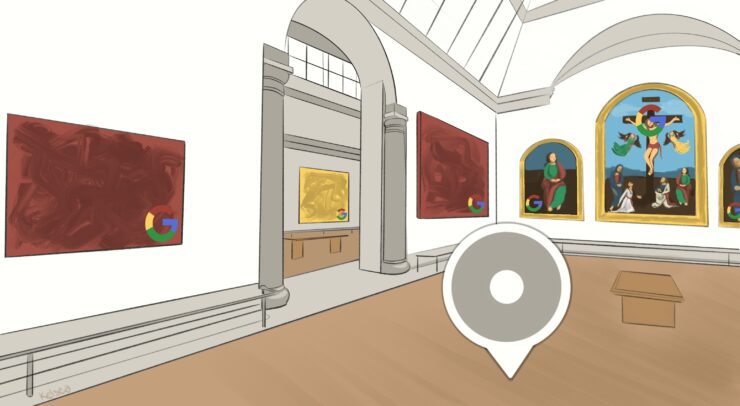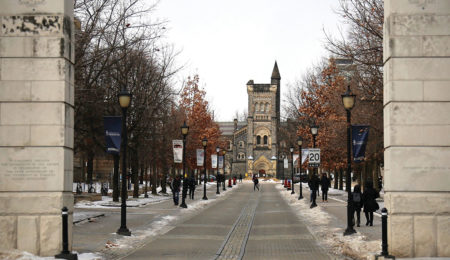Can the experience of viewing art in person truly be replicated online?
Society has gone digital.
In much of the world, the Internet has changed the way people consume information, access knowledge and information, and get their share of entertainment. Chances are while you’re reading this very article online, you’ll be listening to a handpicked playlist on Spotify or Apple Music, maybe as a prelude to a Netflix or Hulu binge. While it seems every other part of human culture has been digitized, the realm of fine arts is on its way to doing the same.
At the forefront of this movement is Google. Launched in 2011, Google Arts & Culture is made up of a number of services attempting to replicate the experience of visiting an art gallery by simply looking at a computer or cellphone screen.
“The aim of Google Arts and Culture is twofold,” a statement sent to the Fulcrum by Google reads. “First, it gives access to art and culture to everyone, everywhere. Second, we are an innovation partner to the cultural sector. We work (with) cultural organizations to help them share and preserve cultural content and create exciting cultural experiences using cutting edge technology.”
Currently, Google Arts and Culture is home to six million photos, videos, and manuscripts obtained from 1,800 galleries and museums from 80 countries. The platform also holds over 7,000 digital exhibitions from museums as big as the Tate Modern, the Museum of Modern Art, and the Metropolitan Museum of Art, tailored especially for online viewing.
Google’s “Art Camera” provides high-resolution imagery of the more popular works, allowing online viewers to see details right down to the brushstroke. They also use their Street View technology to allow online viewers to take a virtual tour through many of the institutions partnered with the program.
A virtual gallery space
Google insists that the intention of their platform is to promote and preserve visual art and culture in the digital age. According to their statement, Google “collaborate(s) with the cultural sector to innovate together and develop technologies that meet their needs.”
Many of Canada’s art institutions have embraced this opportunity to modernize, and some well-known pieces in Canadian collections have been made accessible on Google Arts and Culture.
“Not everyone has access to bricks-and-mortar museums,” says Sara Angel, founder and executive director of the Art Canada Institute. “The opportunity to view art online offers increased accessibility to visual culture.”
“We live in a time where our first experience of almost anything—going to a restaurant, buying a car, visiting a new country — happens online,” Angel added. “Placing a museum’s collection online … (offers) its audience an introduction, a way in, and an initial understanding of its holdings.”
Google Arts and Culture has also become a tool for marketing collections or providing access to work that would otherwise remain in anonymity in private collections or distant exhibitions.
“In our case, the museum is not open to the public,” says Amy Jenkins, head of the Canada Council Art Bank. “Our artworks are placed in government and private sector offices and in exhibitions, so it’s difficult to see our collection. So if you do want to access our collection, all of our works are online, which is great if you want to explore the collection.”
Through an artist’s eyes
Visual art, and the galleries and museums that carry it, have long struggled with a reputation of pretentiousness and antiquity. Experts such as Angel see platforms like Google Arts and Culture as a way for art to maintain relevance with younger generations in the modern world and foster a new generation of art-lovers.
However, artists and members of the global art community fear that programs such as Google’s are threatening to the preservation of the physical gallery, or at least degrading the experience of viewing art altogether. Artists and art professionals alike see digital galleries as supplementary to gallery viewing, not a replacement of it.
“I don’t think it’s a comparable experience … nothing replaces the scale of a work when you’re standing in front of it,” Jenkins says. “How your body reacts to seeing a work in person in a physical space is one thing, and also being able to explore the materiality of the work, the frame, the canvas, the paper, watercolour or pastel … nothing really replaces that experience.”
“I don’t think Google Arts and Culture is necessarily the future of galleries,” says Artemis Theophylactou, an artist and teacher at Mayfield Secondary School’s Regional Art Program.
“I think (the program) is great as a companion … for people who are studying art or philosophy or history, or even people who are going on vacation if they are interested in art and want somewhere new to go. But I will always go to galleries … the space itself is very meditative for me.”
Ron Clifford, a photographer and artist based in Newmarket, Ontario, agrees.
“A physical piece of work requires your physical presence,” Clifford says. “There’s something visceral about being in the tangible space of great art.”
The consensus from the artists and art professionals seems to be that the emotional response to artwork cannot be replicated digitally, and if for no other reason than that, the traditional gallery is not on the verge of extinction.
However, the publicity, exposure, education and access that platforms like Google Arts and Culture provide is an important step towards modernizing the industry as well as diversifying the audience.
“The world is becoming a more accessible place,” Clifford says. “(As) we’ve seen with musicians, the access to quality art is no longer limited by gatekeepers like galleries. Galleries can grow and be relevant, but if they continue to try to be the gatekeeper of all art, they’re going to shoot themselves in the foot.”
However, not all art institutions are convinced that digital accessibility is the future of art. Ottawa’s own National Gallery of Canada declined to comment for this story. Currently, they do not collaborate with Google Arts and Culture. If you want to see any of the thousands of paintings, drawings, sculptures or installations that are part of the collection, you’ll have to head to Sussex Drive yourself.
The Google Gallery
The fight to keep art honest is an important one. Like music or film, art is an avenue through which artists can draw attention to important issues and provoke meaningful conversation. If digital galleries are the way to protect this aspect of humanity, perhaps the sacrifices to the experience are worthwhile.
“I had this conversation with my optometrist, once,” Jenkins says. “She said, ‘I see my clients every day, but it’s always for the same thing … (but) in your work, art covers all sorts of subject matter and points of view.’”
“Artists deal with very difficult issues, very contemporary issues, of identity, migration, diaspora (and) I think tapping into the world of fine art is more than just an aesthetic experience, it’s an intellectual experience as well.”
But in a world where everything is instantaneous, there is certainly an argument to be made about keeping art sacred. Fine art often takes a lifetime to create, and the thought that it could be scrolled past like a Facebook status seems like sacrilege. Art is intended to be admired, not glanced over. But on the other hand, how can art be appreciated if locked behind closed doors?
“Cultural expression is a human right — one so essential that the United Nations General Assembly enshrined it in the Universal Declaration of Human Rights in 1948,” Angel points out. “Online availability of art not only introduces new audiences to culture but offers them a fundamental human right: access to, and awareness of cultural expression through the visual arts.”
No amount of pixels will ever be able to replicate the feeling of standing in front of Michelangelo’s David. But for the vast majority of people who don’t have a few thousand dollars and a week’s time off work to head to Florence and the Galleria Dell’Accademia, maybe Google Arts and Culture is the next best thing.
Zoë Mason knows both Artemis Theophylactou and Ron Clifford from her involvement in the Toronto art scene.
Correction Feb. 22, 5:24 p.m.: This article has been updated to properly spell Sara Angel’s first name.





